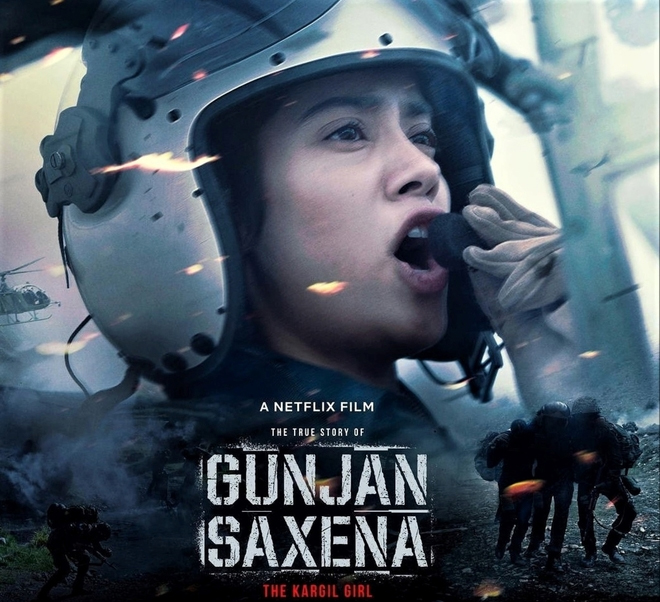
The surge of involvement of women in the fields of Defence such as navy, airforce, and army has given rise to a plethora of movies in Bollywood revolving around it. One of these is Netflix’s recent release Gunjan Saxena: The Kargil Girl, which depicts the story of the first Indian female pilot in combat. The trailer was met with objections for the wrong portrayal of the Air Force itself.
Movies like Raazi, have glamorised the role of the female undercover RAW agent to a certain extent for seeking the attention of the audience. These blockbusters are based on real-life women who contributed hugely to their fields. Yet somewhere, it is very evident that their life stories have been morphed to entertain the audiences. Even though films are mostly based on the truth, they do have the creative liberty to emphasise certain aspects of their stories.
Since the release of the Gunjan Saxena film, the Indian Air Force (IAF) has complained about the undue negative portrayal of the air force to glorify the character. There were instances in the movie— claimed by the IAF— which go against the rules of IAF protocol itself and they do not condone such behaviours.
The Indian Air Force (IAF) has written a letter to the Central Board of Film Certification(CBFC) against its ‘undue negative portrayal’ in the movie Gunjan Saxena: The Kargil Girl.
In the letter to the CBFC, which has also been sent to Netflix and Dharma Productions, it is stated that “Dharma Productions had agreed to represent IAF with authenticity and make all efforts to ensure that the film helps to inspire the next generation of IAF officers.” However, it was observed that “In the aim to glorify the screen character of ‘Gunjan Saxena’, M/s Dharma Productions presented some situations that are misleading and portray an inappropriate work culture especially against women in the IAF.”
The IAF has also said, “The organisation is gender neutral and has always provided an equal opportunity to both male and female personnel.”
Just a day after the IAF raised these objections, Gunjan Saxena herself opened up about her experience and what was portrayed in the film. She mentioned that the IAF is at the core of the movie. She acknowledged that it was the same training and the strong ethos of the IAF, which gave her the courage to do all those extraordinary things. She confirmed that the IAF had given her equal opportunities as her male counterparts during her training as they do even today. Pointing at the increase in the number of women officers in the IAF over the past twenty years, she says this is proof that the Air Force, which is a deeply respected institution, has always made progressive and positive changes to itself as and when needed.
She acknowledges that the film had modified her life story as a commercial film. She shed some light on the years of constant efforts made by IAF in increasing the participation of women in the Air Force.
Retired Wing Commander Namrita Chandi, who trained with former IAF pilot Gunjan Saxena wrote an open letter calling out Dharma Productions for peddling in lies and reiterating that she never faced the kind of abuse shown by the producers. She mentioned instances when her “brother officers” would stand guard outside while she changed and that they were true gentlemen and professionals. She also went on to say that Janhvi Kapoor, the actress who played Gunjan Saxena in the movie, should not have done such a film if she was a proud Indian woman.
It has also come to light that Gunjan Saxena was neither the first woman to be posted to the Indian Air Force’s critical Udhampur helicopter base, nor the first woman to fly during the Kargil battle of 1999, but it was, in fact, her coursemate Flight Lieutenant Sreevidya Rajan.
Rekha Sharma, Chairperson of the National Commission of Women(NCW), tweeted that any movie that negatively portrays our forces, especially when that is against the facts, should not be screened and that the filmmakers should apologise.
Captain Shikha Saxena, who was part of the first group of hundred-plus women recruited by the Indian Army and a contemporary of Gunjan Saxena, expressed her concerns over the movie. In her statement, she explained how her daughters started questioning the reality of the IAF after watching the movie. “Are the makers of Gunjan Saxena — The Kargil Girl and other such content accountable to the society?“
The movie Raazi based on the book “Calling Sehmat,” written by Harinder Sikka, had many such instances that did not line up with the novel. The author had expressed his concerns in interviews and through Twitter. The book states that when Sehmat came back to India, there was a royal red carpet welcome, she saluted to the tricolour while the military band played the National Anthem— something that was not shown in the movie.
Hollywood movies like GI Jane also received a fair amount of criticism from military personnel. Hawkins, president of the Underwater Demolition SEAL Association, maintains that G.I. Jane is a “damaging fantasy.”
This further makes us question how accurate these movies are and which parts of the military life have not yet been brought to light. There is a massive archive of films based on wars called anti-war films, which aim at horrifyingly depicting war. These movies are meant to discourage people from the idea of waging war and to prove that it only results in casualties and loss on both sides. Even though these movies have been around for a long time, critics have claimed that these movies inherently glorify conflict even though they claim to be having a pacifist agenda. BBC’s Tom Brook has written in detail about this.
“There’s no such thing as an anti-war film,” is a quote by the late French filmmaker François Truffaut, which has several interpretations. However, most believe that he was suggesting that movies will inevitably glorify combat when they portray the adventure, thrill of conflict– and the camaraderie between soldiers. This is one of the reasons that cinema may prove to be an inadequate medium to depict the conflict of war.
Elie Wiesel, who is a Holocaust survivor, has said that the reality of the Auschwitz concentration camp was so disturbing that no form of media could truly convey the reality. She went on to say that no matter how hard the film-industry tried, any narrative of the events would always be in its trivialised form.
These were just a few examples of misrepresentation of real-life incidents in movies for building a more substantial, and relatable protagonist. The film industry undeniably has the right to make a film more impactful to commercialise it, but where do we draw the line between creative liberty and the truth?
Written by Cynthia Maria Dsouza and Anwesha Bhattacharjee for MTTN
Edited by Radhika Taneja for MTTN
Feature Image from netflix.com
Image source: dnaindia.com
Leave a Reply
You must be logged in to post a comment.